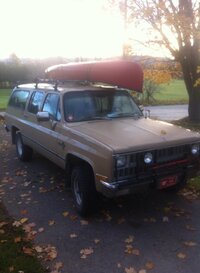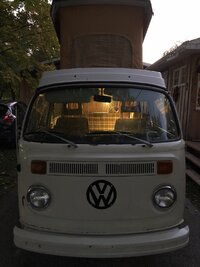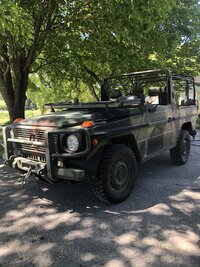So, I have served on an engineering regulatory committee with a guy for about 26 years and at our last meeting in November/2022 he said,
"Pete, you know a lot about cars and you know car people - do you know anyone who likes antique cars?" I replied that
I like antique cars and so he told me that he had an old pickup truck for sale - and he showed me a picture of it. The vehicle was in Kingston, ON - about 600 km east of us (around 370 miles) but it just so happens that Mrs. MaxPete's mum and my little sister live there and we were going there for Christmas - sooo, on Boxing Day, we went to see the truck - and I wound up buying it.
It is a 1920 Model T that is fully restored (but in completely unmodified condition), everything works - including the electric starter - and it runs like a top. My grandfather had one just like it in the 1920s - in fact, he came from a farm near Mountain Grove, a village about 50 miles due north of Kingston, and his truck was the first motor vehicle registered in the township of Olden.
View attachment 233589
This a view of the left-side (i.e. driver's side) of the engine. Visible are the horn just above the electric starter, the cooling fan and its drive belt, the very simple thermosyphon cooling system (no water pump), the steering column with the two control rods for the throttle and the manual ignition advance, the distributor-less ignition system (the sparks are made in a wooden box mounted below the dashboard inside the cab) and the entire electrical wiring system of the truck - mounted on the wooden firewall.
View attachment 233590
Here is the right hand side of the engine compartment. Note the word "Canada" cast into the top of the cylinder head - this vehicle was built right here in Windsor, ON about 5 km (3 miles) from my office! The engine is a 177 cu.in. (2.9 litre) cast iron inline flathead four that produces about 20 hp. It uses splash lubrication (so no oil pump and no oil filter), a thermosyphon cooling circuit (so no water pump), a "
trembler coil buzz-box" ignition (so no distributor) with a flywheel-mounted magneto.
You can run on the battery or the magneto. The
trembler-coil "spark-maker" is interesting: when you turn the key to
"Battery" they buzz - making a sound that is somewhat like a rattlesnake. The fuel tank is in the cowl above the occupant's knees (YIKES!!) - so no fuel pump - but there is a petcock just like on our bikes (although it is manual and not vacuum actuated). There is no vacuum system on the car, and with a compression ratio of only about 5:1, it likely wouldn't work very well anyway.
The transmission is a two-speed planetary unit with engagement bands and a band brake (the only brake on the vehicle). All of the tranny and brake bands are lined with cotton strips, although modern Kevlar-lined replacements are available. In fact, it appears that just about all the parts are available as well as a whole whackload of aftermarket stuff like two-speed rear axles and actual wheel brakes etc. etc.
The only modern convenience is an electric starter to complement the hand crank - but otherwise, it is truly, a basic machine!
View attachment 233591
Below is view of the truck's interior. The 3-pedal driving system takes a fair bit of getting used to:
- the left-hand pedal engages low gear (mash it to the floor to "go"),
- the right-hand pedal is the brake (YIKES!) and,
- the middle pedal is for reverse gear (when mashed down).
The big lever on the left side (barely visible) is the handbrake (when pulled
back), neutral (when in the
central position) and high gear (when the lever is pushed
forward). All of this results in a somewhat "busy" driving experience that was dubbed the "
Model T Dance" - and yet, oddly, this perfectly logical control setup never caught on....for some reason. Poor Henry - he only built 15 million Model Ts...second only to the VW Beetle.
The throttle is the stalk on the RHS of the steering column and the manual spark advance is on the LHS of the column. There is no heater, no side windows, no rearview mirrors (although Chris has one hung on the rim of the windscreen), no speedometer, no turn signals and no brake lights.
This thing makes an XS650 seem like a
high-tech, ultra-modern wizard-mobile.
View attachment 233592
And here we are, all set for a run into town to the hardware store.....at the top speed of about 40 MPH - but since the only brake is in the transmission (no wheel brakes), that is probably fast enough.
I sure hope the driveshaft never fails......
View attachment 233593
....or perhaps a day motoring
al fresco to the market or the beach with my lady-friend.
View attachment 233594
The cool thing (for me at least) is that it is a Canadian vehicle that was built 102 years ago, right here in Windsor, Ontario (zoom in on the RHS of the cylinder head casting and you will see "Canada").
It has a
left side door which only Canadian-built "T"s had because they were mainly intended for the British Empire markets in which people drive on the
wrong side of the road. The rationale is that the brake / clutch / high gear lever beside the driver's position effectively blocks the door - and so it is customary to enter the vehicle on the
passenger side and slide across to the driver's position. Thus, in North America, you really only need a door on the
right side, but in
right-hand drive markets like the UK, New Zealand, Australia and South Africa etc., you need a door on the
left side.
Henry was an ambitious fellow and wanted to be able to export his products around the world, so he incorporated Ford of Canada in 1904 - just after he started the Ford Motor Co. in Detroit. Windsor was the closest he could get to Detroit - while gaining duty-free access to the British Empire market. Thus, Ford built the Canadian cars with doors on
both sides so that they could easily be exported (duty free) to British Empire markets and many Canadian-built Ts were exported to those markets with all RH drive controls. Ford still has major engine-building operations including a foundry and an aluminium casting plant here in the City and I have many friends who work there.
Anyhow, I don't have the truck yet - my buddy is delivering it in the spring (he has a big trailer). I will report again when I get it down here and, hopefully, figure out how the heck to drive it.
Pete





